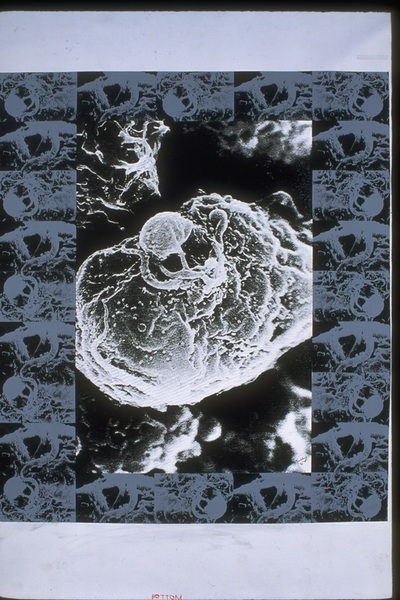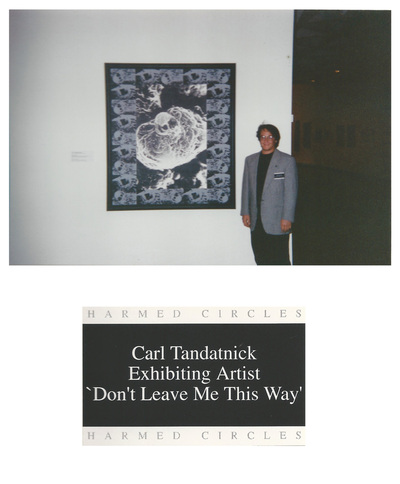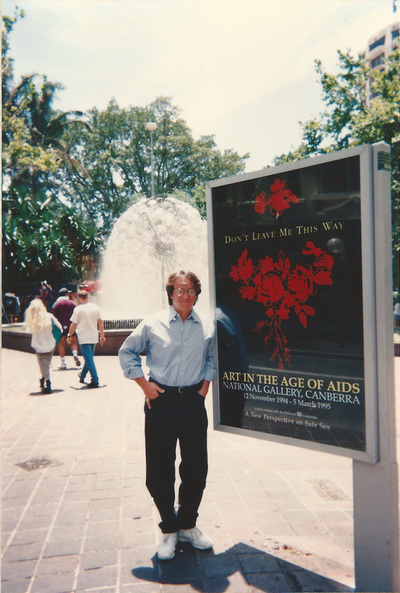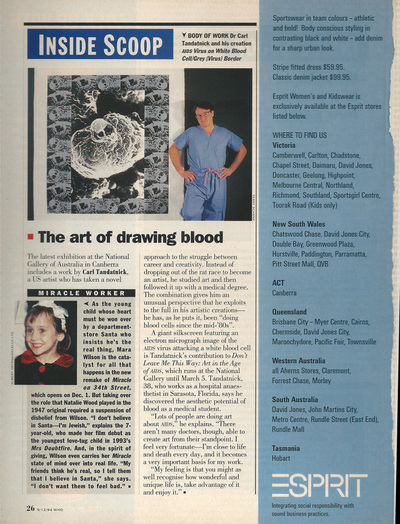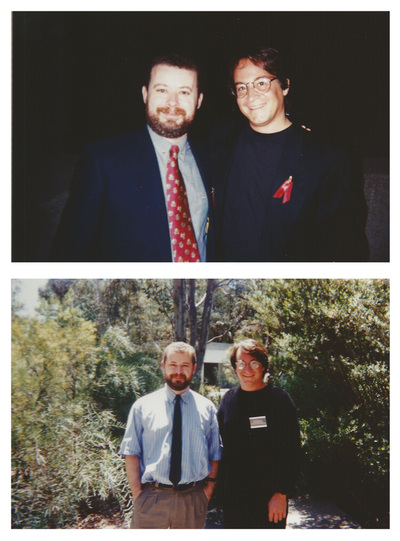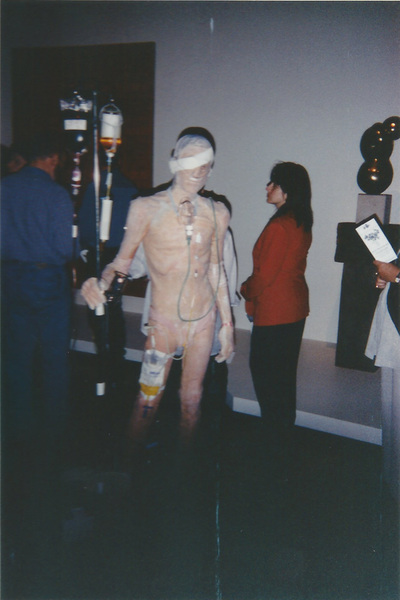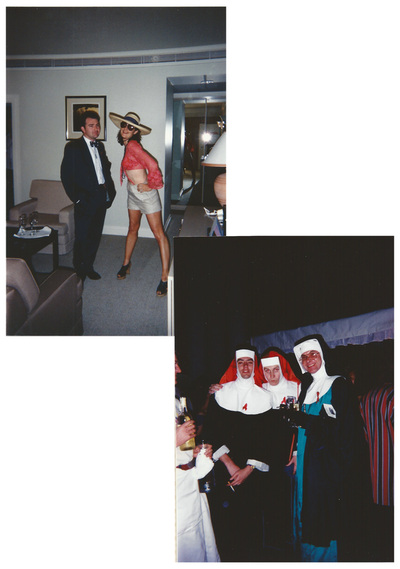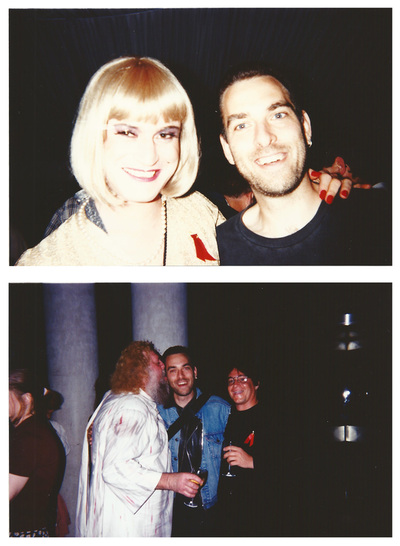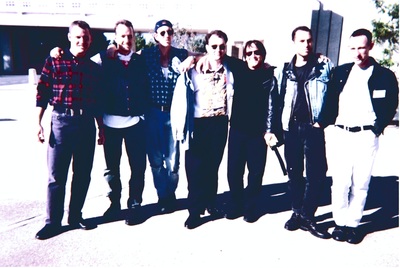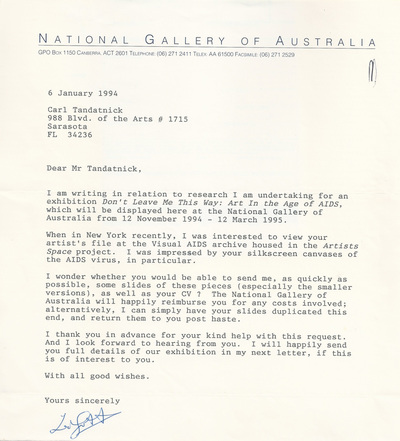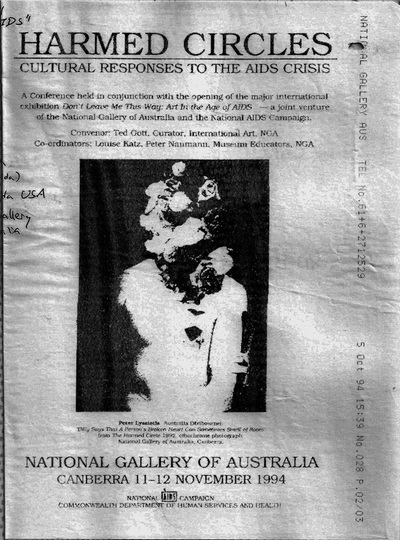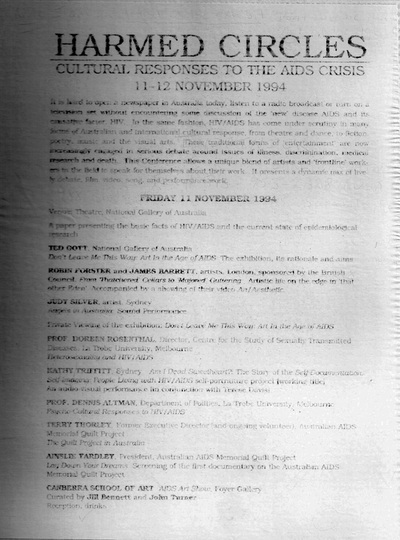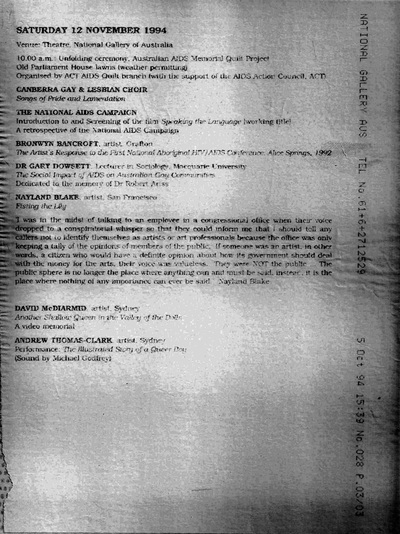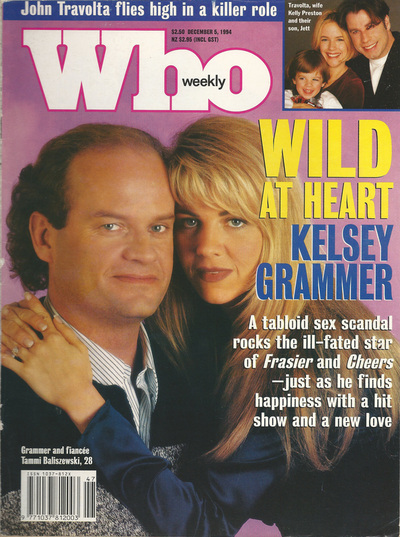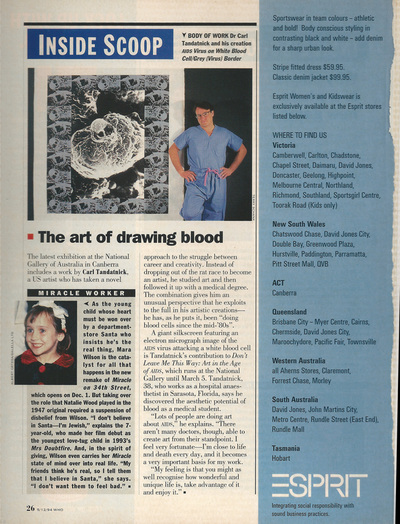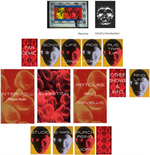National Gallery of Australia
Exhibition 1995
Don't Leave Me This Way
Click on images to enlarge
Introduction
Don't Leave Me This Way - Ted Gott
Curator, International Art National Gallery Of Australia
Tragically Don't Leave Me This Way: Art in the Age of AIDS, as the largest exhibition of it's kind yet unveiled in Australia, reflects the relentless onslaught of HIV/AIDS on the personal, social, moral and political fabric of western societies. It unveils the extraordinarily gifted and passionate artistic statements being produced, both within Australian and overseas, by artists attempting at once to work through their reactions to the direct and searing impact of AIDS on their own diverse lives, and create visual statements that will speak to, empower and educate their audiences in truly the widest sense.
I know that many people expect only depression and gloom from a topic as volatile and "loaded" as HIV/AIDS. We also now know that our audiences have been surprised to find this is a passion, heartbreaking bewilderment, wielding anger and awe-inspiring courage. This is an exhibition which truly rages against the dying of the light, which sings lyrically of the defiant joy to be found in the tenderness of life lived in the face of darkness.
The American writer Cookie Mueller, who died of AIDS in 1989, wrote her artist friends and their work on the AIDS epidemic:
These were the kind of people who lifted the quality of all our lives, their war was against ignorance, the bankruptcy of beauty and the truancy of culture. They were a people who scorned pettiness, intolerance, bigotry, mediocrity, ugliness and spiritual myopia; the blindness that makes life hollow was unacceptable.
They tried to make us see.
The more than 100 artists whose work comprises Don't Leave Me This Way: Art in the Age of AIDS are "these kinds of people."
Artists represented in the exhibition include, from Australia: Michele Barker, Marcus Bunyan, Juan Davila, Jamie Dunbar, David Edwards, Andrew Foster, Brenton Heath-Kerr, Mathew O'Donnell, Rea, Franka Sena, Kaye Shumack, Ross T. Smith, Ross Watson, and William Yang.
From the United States: Nayland Blake, Bill Bytsura, Mark L Chester, Gran Fuiy, Keith Haring, Bill Jacobson, Cary Leibowitz/Candyass, Cynthia Madansky, Robert Mapplethorpe, Duane Michals, Donald Moffett, Christopher Pekoe, Michael Rosen, Andres Serrano, Cindy Sherman, Rosalind Solomon, Carl Tandatnick, Masami Teraoka, David Wojnarowicz, and Thomas Woodruff.
From Great Britain: James Barret and Robin Forester, Derek Jarman, and Ridgeway Bennett.
From France: Pierre et Gilles.
In addition to paintings, sculpture, photography, computer imaging and installation work dealing with a multiplicity of issues surrounding HIV/AIDS, Don't Leave Me This Way reflects the impact of AIDS on gay "popular culture," incorporating spectacular Sydney Gay and Lesbian Mardi Gras costumes and dozens of radical gay and lesbian street demonstration graphics, by groups such as ACT UP, Gran Fury, WHAM, GANG, and F.A.G.S. This is a "first" for a national institution in this country.
The exhibition considers issues such as grief, loss, and commemoration; political art of the streets; the mapping of the body in the ages of AIDS; sexual politics, stereotypes and prejudice; art and censorship. It is designed to both challenge and confront viewers: the seriousness of this issue demands nothing else.
To accompany this exhibition, the National Gallery of Australia has also published a 250-page book of the same title, Don't Leave Me This Way: Art in the Age of AIDS (dsitributed by Thames and Hudson). Topics and authors include: the response to HIV/AIDS by Australia's gay and lesbian artists (Ted Gott); the impact of AIDS on gays in Britain (Simon Watney); AIDS used as a "moral" weapon to censor art in the United States (Carole S. Vance); psycho-cultural responses to HIV/AIDS (Denis Altman); PLWA portraiture (Jan Zita Grover); aesthetics and loss (Edmund White); and a re-evaluation of American cultural responses to the AIDS crisis in the epidemic's second decade (Thomas W. Sokolowski).
The exhibition has been generously sponsored by the Australian National AIDS Campaign, reflecting the Australian Commonwealth Department of Human Services and Health's recognition of the significance of the visual arts to the education and information of the populace at large.
The true working nature of this visual dialogue has been amply demonstrated by the attendance records for the exhibition. Since opening last November, Don't Leave Me This Way: Art in the Age of AIDS has received some 10,000 visitors each week. A whole cross-section of Australian society, in terms of age, sexualities, ethnic backgrounds has visited the exhibition to date. On the whole visitors view the exhibition in solitude, careful attention being paid to each work on display, and an unusually high rate of people reading each and every label, and leaving the show with the exhibition's room brochures in hand.
Public response to the exhibition has been extraordinarily supportive and moving. Comments have ranged from an 11 -year old girl who found the show "Better than TV"; to a group statement, "We'd like to thank the Australian National Gallery for putting on this exhibition. We found it touching and brave," from a Year 9 school class.
Works within the exhibition are also clearly speaking directly to our public. Carl Tandatnick's AIDS Virus On White Blood Cell/Grey (Virus) Border 1993, a colorful silkscreened reworking of an electron micrograph image, has proved to be one of the most popular images in the exhibition, and has already been "appropriated" by teenagers from the Canberra region and reworked into a new local safe-sex T-shirt design. Tandatnick's canvas, placed at the opening of the exhibition, is one of the key pieces aimed at encouraging viewers to shed preconceptions and prejudices about HIV/AIDS and the people who are affected by it; and remember that AIDS is caused by a microscopic virus, and not by someone’s belonging to a particular race of class or having a certain lifestyle.
National press and television coverage of the exhibition has been both widespread and thoroughly supportive of the aims and endeavours of the project. Coverage of the show in the gay and lesbian press has also been extensive and positive. The National Gallery of Australia has to date received only one letter of complaint from a member of the public, and this was penned three weeks before the exhibition opened in November 1994. An expected wave of public complaint about a potentially controversial show containing much sexuality "up front" art, has failed to materialise. The New Right has remained silent in the face of this visual gauntlet thrown before bigotry, prejudice and vilification. Instead, the National Gallery has received an avalanche of "love letters" from the Australian populace and a groundswell of community support to the people on a direct and emotionally engaging level.
Press The Art Of Drawing Blood Who Weekly (Australia’s People Magazine)
The latest exhibition at the National Gallery of Australia in Canberra includes a work by Carl Tandatnick, a US artist who has taken a novel approach to the struggle between career and creativity. Instead of dropping out of the rat race to become an artist, he studied art and then followed it up with a medical degree. The combination gives him an unusual perspective that he exploits to the full in his artistic creations-he has, as he puts it, been "doing blood cells since the mid-'80s".
A giant silk-screen featuring an electron micrograph image of the AIDS virus attacking a white blood cell is Tandatnick's contribution to "Don't Leave Me This Way: Art in the Age of AIDS," which runs at the National Gallery until March 5. Tandatnick, 38, who works as a hospital anesthetist in Sarasota, Florida, says he discovered the aesthetic potential of blood as a medical student.
"Lots of people are doing art about AIDS,” he explains. "There aren't many doctors , though, able to create art from their standpoint. I feel very fortunate-I'm close to life and death every day, and it becomes a very important basis for my work.
"My feeling is that you might as well recognize how wonderful and unique life is, take advantage of it and enjoy it."
Don't Leave Me This Way - Ted Gott
Curator, International Art National Gallery Of Australia
Tragically Don't Leave Me This Way: Art in the Age of AIDS, as the largest exhibition of it's kind yet unveiled in Australia, reflects the relentless onslaught of HIV/AIDS on the personal, social, moral and political fabric of western societies. It unveils the extraordinarily gifted and passionate artistic statements being produced, both within Australian and overseas, by artists attempting at once to work through their reactions to the direct and searing impact of AIDS on their own diverse lives, and create visual statements that will speak to, empower and educate their audiences in truly the widest sense.
I know that many people expect only depression and gloom from a topic as volatile and "loaded" as HIV/AIDS. We also now know that our audiences have been surprised to find this is a passion, heartbreaking bewilderment, wielding anger and awe-inspiring courage. This is an exhibition which truly rages against the dying of the light, which sings lyrically of the defiant joy to be found in the tenderness of life lived in the face of darkness.
The American writer Cookie Mueller, who died of AIDS in 1989, wrote her artist friends and their work on the AIDS epidemic:
These were the kind of people who lifted the quality of all our lives, their war was against ignorance, the bankruptcy of beauty and the truancy of culture. They were a people who scorned pettiness, intolerance, bigotry, mediocrity, ugliness and spiritual myopia; the blindness that makes life hollow was unacceptable.
They tried to make us see.
The more than 100 artists whose work comprises Don't Leave Me This Way: Art in the Age of AIDS are "these kinds of people."
Artists represented in the exhibition include, from Australia: Michele Barker, Marcus Bunyan, Juan Davila, Jamie Dunbar, David Edwards, Andrew Foster, Brenton Heath-Kerr, Mathew O'Donnell, Rea, Franka Sena, Kaye Shumack, Ross T. Smith, Ross Watson, and William Yang.
From the United States: Nayland Blake, Bill Bytsura, Mark L Chester, Gran Fuiy, Keith Haring, Bill Jacobson, Cary Leibowitz/Candyass, Cynthia Madansky, Robert Mapplethorpe, Duane Michals, Donald Moffett, Christopher Pekoe, Michael Rosen, Andres Serrano, Cindy Sherman, Rosalind Solomon, Carl Tandatnick, Masami Teraoka, David Wojnarowicz, and Thomas Woodruff.
From Great Britain: James Barret and Robin Forester, Derek Jarman, and Ridgeway Bennett.
From France: Pierre et Gilles.
In addition to paintings, sculpture, photography, computer imaging and installation work dealing with a multiplicity of issues surrounding HIV/AIDS, Don't Leave Me This Way reflects the impact of AIDS on gay "popular culture," incorporating spectacular Sydney Gay and Lesbian Mardi Gras costumes and dozens of radical gay and lesbian street demonstration graphics, by groups such as ACT UP, Gran Fury, WHAM, GANG, and F.A.G.S. This is a "first" for a national institution in this country.
The exhibition considers issues such as grief, loss, and commemoration; political art of the streets; the mapping of the body in the ages of AIDS; sexual politics, stereotypes and prejudice; art and censorship. It is designed to both challenge and confront viewers: the seriousness of this issue demands nothing else.
To accompany this exhibition, the National Gallery of Australia has also published a 250-page book of the same title, Don't Leave Me This Way: Art in the Age of AIDS (dsitributed by Thames and Hudson). Topics and authors include: the response to HIV/AIDS by Australia's gay and lesbian artists (Ted Gott); the impact of AIDS on gays in Britain (Simon Watney); AIDS used as a "moral" weapon to censor art in the United States (Carole S. Vance); psycho-cultural responses to HIV/AIDS (Denis Altman); PLWA portraiture (Jan Zita Grover); aesthetics and loss (Edmund White); and a re-evaluation of American cultural responses to the AIDS crisis in the epidemic's second decade (Thomas W. Sokolowski).
The exhibition has been generously sponsored by the Australian National AIDS Campaign, reflecting the Australian Commonwealth Department of Human Services and Health's recognition of the significance of the visual arts to the education and information of the populace at large.
The true working nature of this visual dialogue has been amply demonstrated by the attendance records for the exhibition. Since opening last November, Don't Leave Me This Way: Art in the Age of AIDS has received some 10,000 visitors each week. A whole cross-section of Australian society, in terms of age, sexualities, ethnic backgrounds has visited the exhibition to date. On the whole visitors view the exhibition in solitude, careful attention being paid to each work on display, and an unusually high rate of people reading each and every label, and leaving the show with the exhibition's room brochures in hand.
Public response to the exhibition has been extraordinarily supportive and moving. Comments have ranged from an 11 -year old girl who found the show "Better than TV"; to a group statement, "We'd like to thank the Australian National Gallery for putting on this exhibition. We found it touching and brave," from a Year 9 school class.
Works within the exhibition are also clearly speaking directly to our public. Carl Tandatnick's AIDS Virus On White Blood Cell/Grey (Virus) Border 1993, a colorful silkscreened reworking of an electron micrograph image, has proved to be one of the most popular images in the exhibition, and has already been "appropriated" by teenagers from the Canberra region and reworked into a new local safe-sex T-shirt design. Tandatnick's canvas, placed at the opening of the exhibition, is one of the key pieces aimed at encouraging viewers to shed preconceptions and prejudices about HIV/AIDS and the people who are affected by it; and remember that AIDS is caused by a microscopic virus, and not by someone’s belonging to a particular race of class or having a certain lifestyle.
National press and television coverage of the exhibition has been both widespread and thoroughly supportive of the aims and endeavours of the project. Coverage of the show in the gay and lesbian press has also been extensive and positive. The National Gallery of Australia has to date received only one letter of complaint from a member of the public, and this was penned three weeks before the exhibition opened in November 1994. An expected wave of public complaint about a potentially controversial show containing much sexuality "up front" art, has failed to materialise. The New Right has remained silent in the face of this visual gauntlet thrown before bigotry, prejudice and vilification. Instead, the National Gallery has received an avalanche of "love letters" from the Australian populace and a groundswell of community support to the people on a direct and emotionally engaging level.
Press The Art Of Drawing Blood Who Weekly (Australia’s People Magazine)
The latest exhibition at the National Gallery of Australia in Canberra includes a work by Carl Tandatnick, a US artist who has taken a novel approach to the struggle between career and creativity. Instead of dropping out of the rat race to become an artist, he studied art and then followed it up with a medical degree. The combination gives him an unusual perspective that he exploits to the full in his artistic creations-he has, as he puts it, been "doing blood cells since the mid-'80s".
A giant silk-screen featuring an electron micrograph image of the AIDS virus attacking a white blood cell is Tandatnick's contribution to "Don't Leave Me This Way: Art in the Age of AIDS," which runs at the National Gallery until March 5. Tandatnick, 38, who works as a hospital anesthetist in Sarasota, Florida, says he discovered the aesthetic potential of blood as a medical student.
"Lots of people are doing art about AIDS,” he explains. "There aren't many doctors , though, able to create art from their standpoint. I feel very fortunate-I'm close to life and death every day, and it becomes a very important basis for my work.
"My feeling is that you might as well recognize how wonderful and unique life is, take advantage of it and enjoy it."
Click on images to enlarge
